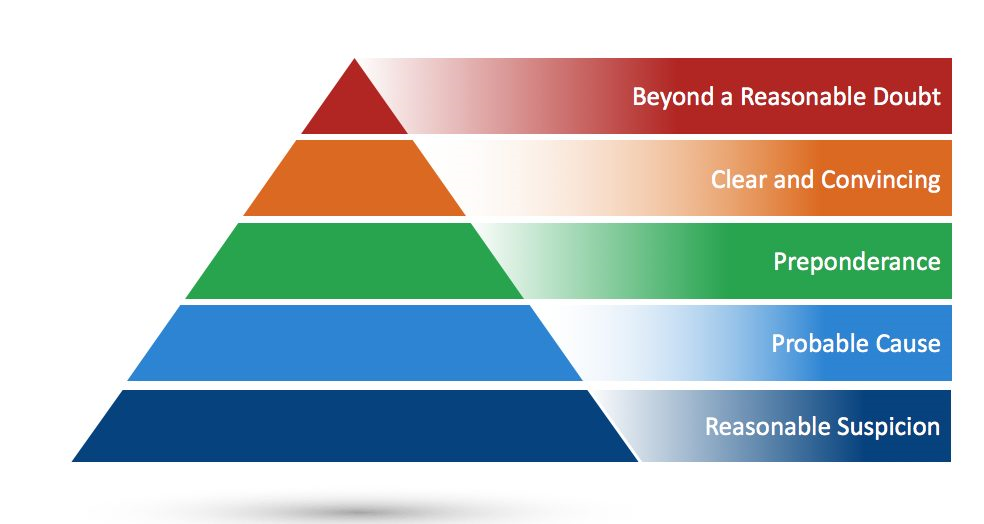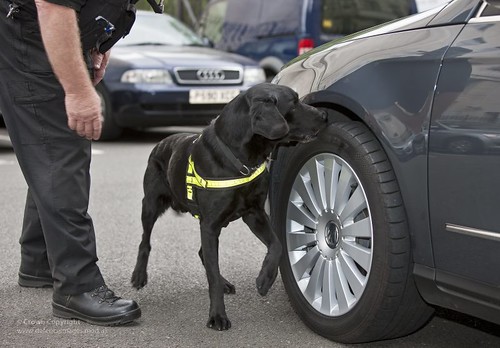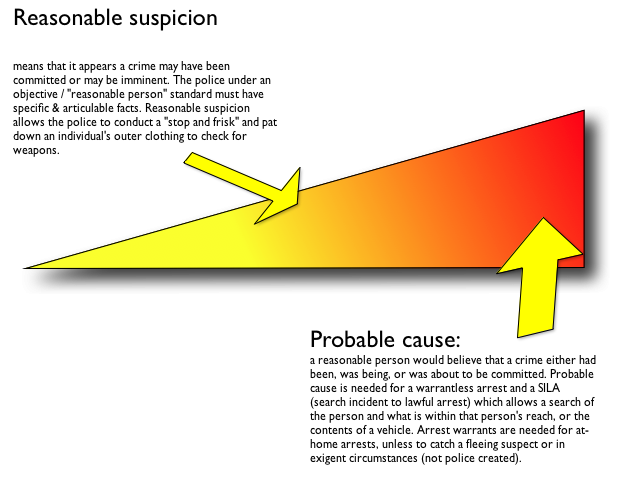Establishing Reasonable Suspicion
Reasonable suspicion is a legal standard that is used in criminal procedure. It is a lower standard than probable cause, but more than just a hunch or instinct. To act on reasonable suspicion, law enforcement must have specific and articulable facts that indicate criminal activity or involvement in a crime. This article will explore what reasonable suspicion is and how it is used when dealing with criminal procedures.
Reasonable suspicion and probable cause are fundamental principles of criminal law that must be understood in order to pursue any legal action. When an officer has reason to believe a crime has been committed, they need to have either reasonable suspicion or probable cause to move forward with an arrest or search. While both terms refer to evidence of criminal activity, they have different meanings and implications.

Reasonable Suspicion vs. Probable Cause
Reasonable suspicion refers to the level of suspicion that an officer needs to have in order to conduct a limited search or seizure of someone’s person or property. It is a lower standard than probable cause, as it allows for less evidence or facts to support search and seizure actions.
Reasonable suspicion exists when an objective person, taking into account the facts and circumstances of a particular situation, would believe that someone was committing a crime. The evidence presented must go beyond a hunch – law enforcement officers must be able to articulate specific reasons why they had a reasonable belief that a crime had occurred, was occurring, or would occur. In other words, reasonable suspicion is only present when there are specific facts that warrant it in the given context.
Evidence used to justify reasonable suspicion can include past criminal behavior, suspicious behavior at the moment of the encounter, or information received from credible sources. Additionally, officers may take into account context when determining what constitutes reasonable suspicion.
What Is Probable Cause?
Probable cause is the stronger of the two standards and requires more specific evidence to justify a search or seizure. In order to establish probable cause, officers must be able to point to specific facts or evidence that suggests a crime was committed by the suspect in question. The evidence must also be sufficient enough that an unbiased person would conclude a crime had been committed. If this threshold is not met, then the search or seizure cannot be conducted legally.
Terry Stops
The Supreme Court’s landmark decision in Terry v. Ohio grants law enforcement the power to perform limited stops and searches of persons whom they have reasonable suspicion to believe are engaging in criminal activity. The “Terry stop” is a powerful tool utilized by law enforcement officers across the United States, allowing them to investigate suspicious behavior without full proof of probable cause for an arrest.

However, many stops based on reasonable suspicion as defined by the Terry standard ultimately rely heavily on suspect descriptions consisting of few descriptors, or with discrepancies between the description given and the appearance of the individual stopped. In such cases, it is important to consider the necessity of particularizing the reasonable suspicion factor based on these suspect descriptions, and how courts should view vague or discrepant information when determining this reasonable suspicion.
How Is Reasonable Suspicion Used?
When reasonable suspicion exists, law enforcement may briefly detain the individual to question them or frisk them for any weapons. This can only last for a brief period of time, however, as further investigation is needed to establish probable cause. In certain situations, police may also use less intrusive means such as surveillance to get more information. The aim of reasonable suspicion is to protect citizens from unnecessary searches while also allowing law enforcement to investigate suspicious behavior.
Some examples of reasonable suspicion might include:
- Nervous Behavior: An individual exhibiting unusually nervous behavior, such as fidgeting, avoiding eye contact, or appearing agitated in a manner that raises suspicion.
- Matching a Suspect Description: If a person matches the description of a suspect in an ongoing investigation, law enforcement might have reasonable suspicion to detain them briefly.
- Fleeing or Evasive Actions: Someone running away upon seeing law enforcement or attempting to evade police presence might create reasonable suspicion.
- Presence in a High-Crime Area: Being in an area known for criminal activity or with a high crime rate, especially at odd hours, could raise suspicion.
- Anonymous Tips: A reliable anonymous tip that provides specific and detailed information that aligns with potential criminal activity.
- Unusual Conduct: Engaging in suspicious or unusual behavior that leads law enforcement to reasonably suspect criminal activity.
- Information from Informants: Information from a known or reliable informant about potential criminal activity can create reasonable suspicion.
Remember, reasonable suspicion is subjective and based on the totality of circumstances. It’s important that law enforcement officers can articulate their reasons for suspecting someone of criminal activity based on observable, objective facts.

Reasonable suspicion does not give law enforcement the right to conduct a full search or make an arrest. It’s only sufficient to justify a temporary detention or a brief stop for questioning. Probable cause, a higher standard, is needed to make an arrest or conduct a search.
Reasonable Suspicion in DUI Stops
Law enforcement must have reasonable suspicion to conduct a traffic stop on a motor vehicle. When this doesn’t occur, any criminal DWI charges that stem from the stop are rendered invalid. This is due to the exclusionary rule which states that evidence discovered as a result of unconstitutional activity cannot be used against the accused in criminal proceedings.
Police officers can only stop your vehicle if they have a reasonable suspicion of unlawful behavior. Reasonable suspicion is based on an objective evaluation of the facts and circumstances of a particular situation. Certain factors are more likely than others to support a finding of reasonable suspicion.
- You Run a Stop Sign or Red Light: Rolling through a stop sign or running a red light would give police officers enough cause to justify making a stop.
- You Fail to Maintain Your Lane: Difficulty maintaining your lane or frequent lane changes while driving can indicate that you are intoxicated, which supports reasonable suspicion and justifies a police officer making a stop.
- You Drive Below the Speed Limit: Consistently driving 10-15 MPH – or more – below the posted speed limit may create reasonable suspicion for officers to make a stop.
- You Drive Against Traffic: Driving against traffic is a major red flag and a clear indication that something may be amiss, giving rise to reasonable suspicion.
- Your Vehicle Has Issues: Officers also have the power to pull you over due to certain issues with your vehicle, such as faulty lights or an outdated inspection sticker.
- You Were Speeding: Driving above the posted speed limit is a violation of the law and gives rise to reasonable suspicion for making a traffic stop.
- You Narrowly Escaped an Accident: If an officer witnesses you narrowly escaping an accident, there is enough reason to suspect that you are at fault and stop your vehicle.
- You Made an Illegal Turn: Making an illegal U-Turn or an unauthorized right turn on red are all violations of the law that could result in a traffic stop.
- You Brake Frequently: Excessive caution behind the wheel, such as braking frequently, can indicate to officers that something is wrong, warranting a traffic stop.
Real-Life Examples of Reasonable Suspicion:
Nervous Behavior in a High-Crime Area
Scenario: A police officer notices an individual in a known high-crime area exhibiting extremely nervous behavior, constantly looking around and adjusting their clothing. The officer notices a bulge that could resemble a weapon under the person’s clothing.
The officer has reasonable suspicion to briefly stop and question the individual.
Matching Suspect Description
Scenario: Law enforcement receives a report about a theft at a mall. The suspect was described as a tall male wearing a red hoodie and jeans. An officer sees an individual matching this description leaving the mall.
The officer has reasonable suspicion to detain the person briefly for questioning.
Anonymous Tip with Corroborating Evidence
Scenario: Law enforcement receives an anonymous tip detailing an individual selling drugs in a specific parking lot at a certain time. An officer goes to the location and observes the described activity.
The anonymous tip, coupled with observed behavior matching the tip, provides reasonable suspicion to approach and investigate.
Evasive Action in a High-Intensity Area
Scenario: During a narcotics investigation in a high-crime neighborhood, an individual, upon noticing law enforcement, abruptly changes their walking direction and starts hurriedly moving away.
This action, combined with the context of the area’s known criminal activity, provides reasonable suspicion for law enforcement to conduct a brief stop and question the individual.
Anonymous Tip Corroborated by Observation
Scenario: Law enforcement receives an anonymous tip about a person carrying a weapon in a shopping mall. An officer observes an individual fitting the provided description acting nervously and appearing to conceal an item under their jacket.
This observed behavior aligns with the anonymous tip, providing reasonable suspicion for a brief detention and investigation.
Matching Suspect Description with Unusual Behavior
Scenario: A suspect in a recent burglary is described as a tall individual wearing a distinctive jacket with a specific logo. An officer spots someone matching the description loitering near a house that was recently burglarized.
The person’s behavior, such as looking into windows and checking doors, adds reasonable suspicion for a brief detainment to confirm identity and intentions.
Questionable Reasonable Suspicion Scenarios:
Being in a High-Crime Area Alone
Scenario: A person is walking alone in a high-crime area, and despite not displaying any suspicious behavior, an officer stops and questions them based solely on their location.
This could be seen as questionable as the individual’s behavior was not suspicious in any way.
Traffic Stop Based on a Hunch
Scenario: An officer stops a vehicle without any observable traffic violations or suspicious behavior. The officer states they had a “hunch” about the driver.
In this case, without any specific, articulable facts, the stop might be considered questionable in terms of reasonable suspicion.
Racial Profiling
Scenario: An officer stops and questions an individual based solely on their race or ethnicity, without any specific behavior or evidence to suspect criminal activity.
Racial profiling is illegal and cannot form the basis of reasonable suspicion.
In all scenarios, the determination of whether reasonable suspicion is valid is subject to the specifics of the situation, the officer’s observations, and the context in which the suspicion arose. When reasonable suspicion is challenged, it often becomes a matter for legal review to determine if the stop or detention was lawful.
Detained Based on Unsubstantiated Tip
Scenario: Law enforcement stops an individual solely because an anonymous tip mentioned a person wearing a red shirt in a public area. However, there is no observed behavior or evidence to support the suspicion beyond the color of the clothing.
This situation might be considered questionable.
Detained Due to Loitering
Scenario: A person is sitting on a bench in a park, not engaging in any specific or unusual behavior. Law enforcement stops them merely for loitering, without any further evidence of suspicious conduct or criminal activity.
This situation might be questionable as loitering alone is not sufficient for reasonable suspicion.
Subjective Judgment without Observable Behavior
Scenario: An officer detains an individual based on a subjective judgment of their appearance, such as tattoos or hairstyle, without any observable behavior indicating potential criminal activity.
This could be considered questionable as it’s based solely on appearance rather than behavior.
FAQs About Reasonal Suspicion
What is a good example of reasonable grounds for suspicion?
Reasonable grounds of suspicion refer to facts, circumstances, or events that suggest criminal activity is taking place. For instance, if a police officer sees a person in the middle of the night running away from a crime scene with stolen items in their possession, this could provide reasonable grounds for suspicion.
What is meant by reasonable suspicion?
Reasonable suspicion is defined in the United States as a lower standard than probable cause. It requires law enforcement to have facts and evidence that would lead a reasonable and prudent person to believe criminal activity may be afoot.
What is reasonable cause to suspect?
Reasonable cause to suspect refers to facts, circumstances, or events that suggest criminal activity is likely occurring. In other words, it is enough to give a person pause and motivate them to further investigate the situation.
What is reasonable suspicion in Black’s Law Dictionary?
According to Black’s Law Dictionary, reasonable suspicion can be defined as “a level of suspicion based upon articulable facts which, taken together with rational inference from those facts, reasonably warrants [a person] intrusion.”
What is the legal definition of reasonable cause?
The legal definition of reasonable cause varies slightly between jurisdictions but generally defines it as:
“sufficient knowledge of facts and circumstances to warrant a man of reasonable caution in the belief that an offense has been or is being committed by a certain person.”
What is reasonable in Black’s Law?
Reasonable in Black’s Law Dictionary is defined as:
“according with natural principles; not extreme; moderately wise or judicious; based on the facts presented and the applicable law; fair; just; proper; supported by convincing proof; proportional.”
What is reasonable suspicion beyond a reasonable doubt?
Reasonable suspicion beyond a reasonable doubt simply means that the facts and evidence present must be sufficient to leave no doubt in a reasonable person’s mind that a crime has been committed. This standard is used more often in criminal proceedings than in civil cases.
How do you prove beyond a reasonable doubt?
To prove something beyond a reasonable doubt usually requires law enforcement to collect and analyze all available evidence and testimonies related to the case. This evidence needs to be so compelling it leaves no room for any doubts about the defendant’s guilt or innocence.
Which of the following does not require probable cause?
A search warrant typically requires probable cause before one can be issued. However, traffic stops do not require probable cause; instead, police need only have reasonable suspicion that a crime or infraction might have occurred.
What is the preponderance of the evidence?
The preponderance of the evidence is defined as “the greater weight of the evidence required in civil cases for the trier of fact (jury or judge without a jury) to decide in favor of one side or the other.” This means that evidence must demonstrate enough to satisfy at least 50% certainty that one party is correct and the other party is wrong.
What is reasonable suspicion in Texas?
In Texas, reasonable suspicion is defined as having “some minimal objective justification” for suspecting criminal activity – such as suspicious behavior or movements, proximity to recently reported crimes, or information obtained through informants.
What is the exclusionary rule of evidence?
The exclusionary rule states that any evidence obtained in violation of an individual’s constitutional rights cannot be used against them in a criminal trial. This rule applies to illegally seized evidence as well as illegally coerced confessions.
What is the difference between reasonable suspicion and probable cause?
Reasonable suspicion is the lower standard of proof used by law enforcement when making an arrest or conducting a search. It requires officers to have specific facts that suggest a person may be or have been involved in the commission of a crime. Probable cause, on the other hand, is the higher standard of proof that requires officers to have evidence sufficient to believe that a person has committed a crime.
Is probable cause a less demanding standard than reasonable suspicion?
No, probable cause is actually a more demanding standard than reasonable suspicion. To establish probable cause, there must be enough evidence to support a reasonable belief that an individual has committed a crime. This is a higher threshold than the standard for reasonable suspicion, which requires only that an officer has facts that suggest a person might be involved in criminal activity.
What would be an example of probable cause?
An example of probable cause could be if law enforcement officers witness a suspect committing a crime or find evidence linking the suspect to a crime. Other examples include observing suspicious behavior or being told by a credible source that someone has committed a crime.
What is the legal definition of reasonable cause?
The legal definition of reasonable cause is when an officer has reasons based upon observable facts to believe that someone has committed, is committing, or will commit a particular offense. In order for an officer to act on this reasonable suspicion, the facts must demonstrate more than mere speculation but can’t reach the level of certainty required by probable cause.
How do you prove beyond a reasonable doubt?
Proving something beyond a reasonable doubt can be difficult as it requires a high degree of certainty. To do so, prosecutors must present strong and convincing evidence to the jury that eliminates any remaining reasonable doubts about the guilt of the accused. The jury then makes its decision based on this evidence and must unanimously agree that the defendant is guilty beyond a reasonable doubt before convicting them.
What is probable cause in the 4th Amendment?
According to the wording of the 4th Amendment, probable cause exists when there is “reasonably trustworthy information” to warrant an officer’s belief that somebody has committed or will commit a crime. Generally speaking, this means that law enforcement must have some form of reliable and trustworthy evidence to support warrantless searches or arrests.




